Kristine Hughes's Blog, page 91
June 13, 2014
THE WELLINGTON CONNECTION - THE ROYAL PAVILION
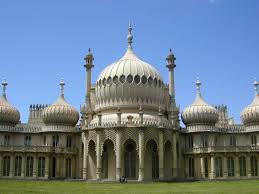
Whilst we'll be visiting many stately homes during the upcoming Duke of Wellington Tour in September, one of the highlights will surely be our visit to the Royal Pavilion in Brighton. Built as George IV's pleasure palace by the sea, the Pavilion continues to astonish visitors, just as it did during the 19th century. One of the most astonished first time visitors was the Duke of Wellington - Princess Lieven took the time to record the Duke's reaction, writing from to her husband from Brighton on January 26, 1822: "I wish you were here to laugh. You cannot imagine how astonished the Duke of Wellington is. He had not been here before, and I thoroughly enjoy noting the kind of remark and the kind of surprise that the whole household evokes in a new-comer. I do not believe that, since the days of Heliogabalus, there have been such magnificence and such luxury. There is something effeminate in it which is disgusting. One spends the evening half-lying on cushions; the lights are dazzling; there are perfumes, music, liquers – “Devil take me, I think I must have got into bad company.” You can guess who said that, and the tone in which it was said. . . . "
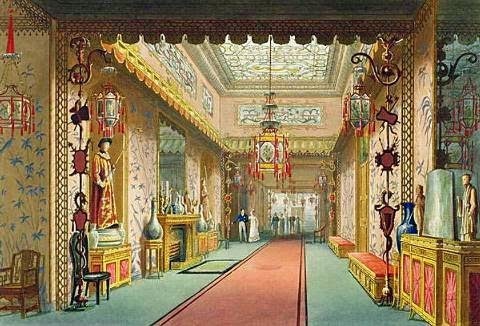
Astonished as Wellington may have been, he revisited the Pavilion, as he visited all of the royal residences, numerous times to fulfill his many official appointments - state, governmental or personal - during the reigns of four British monarchs. Typically, the Duke had nothing more annoying to deal with than the demands of the Prince of Wales, but on another occasion whilst in Brighton, the Duke found himself confronted with the dreaded Lady Caroline Lamb. He recorded the encounter as follows:
Stratfield Saye, 6 April 1823
To Mrs. Arbuthnot
. . . . . . . I saw Calantha (Lady C. Lamb) at Brighton, as mad as a March Hare. She jumped out of her Carriage to come to me on the East Cliffe, and did not wait to have the steps let down! She has written another book, called I don't know what; but she is to send it to me and you shall have it. She says it is doubtful whether it was written by Lord Byron or Thomas Hope!! . . . . . .
Whilst the Pavilion was not a favourite stopping place of the Duke's, it seems that, like it or not, the Duke had a strong influence upon its interiors, as The History of Brighton and Environs by Henry Martin (1871) explains:
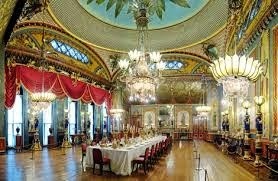
There was formerly in one of the rooms of the Pavilion a Chinese lanthorn, 12ft. by 8ft., and which, on all particular occasions, was brilliantly illuminated on the exterior, thus exhibiting its transparency and producing an effect too exquisite to be described. A small apartment adjacent, called Tippoo Saib's room, was fitted up with ivory chairs, sofas, etc, part of the spoils brought from Seringapatam, after the overthrow of that eastern potentate. All the fittings and embellishments were of a gorgeous character, and in strict harmony throughout the whole of this remarkable building; on occasions, such as State Balls, etc, it must have been a splendid spectacle, the uniforms of the Foreign Ambassadors, General Officers, representatives of various orders, all uniting to make the "coup d'oeil" particularly striking.
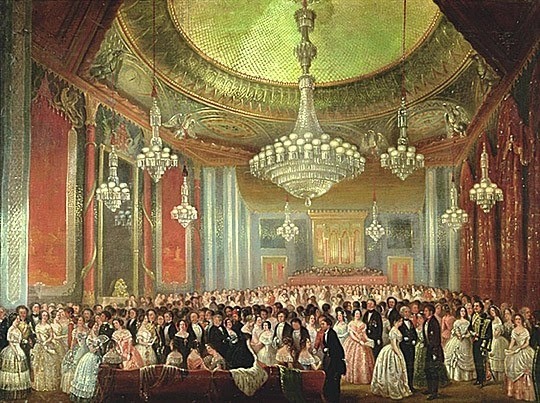
After the death of the Prince Regent, his brother, King William IV, and, afterwards, Queen Victoria both used the Pavilion from time to time. You perhaps won't be surprised to learn that Queen Victoria didn't like it very much - in fact, she felt much the same way about the Pavilion as the Duke of Wellington had, and so sold the Pavilion to the town of Brighton for £50,000 in 1850, taking quite a bit of the furniture and the décor back to Buckingham Palace. Many of those pieces have subsequently been returned to the Pavilion, on loan from the present Queen.
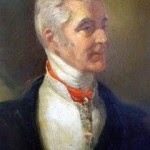
Here is what the Duke of Wellington wrote to Angela Burdett-Coutts on 23 January 1850 about the sale of the Pavilion:
. . . . . I am not surprised that the purchase of the Pavillion at Brighton should be such in that town! The Queen disliked the Residents of Brighton; and Her Majesty is not in a position, I am afraid, to keep up a Palace of that kind at Her Private expense to please the Publick at Brighton! It now belongs to the Crown; and the Publick dislike Palaces to such a degree that it is desirable to get rid of any one at which the Sovereign does not desire to reside . . . . . .
COMPLETE ITINERARY AND DETAILS FOR THE DUKE OF WELLINGTON TOUR CAN BE FOUND HERE
Published on June 13, 2014 00:00
June 11, 2014
THE WELLINGTON CONNECTION: THE HYDE PARK SQUATTER
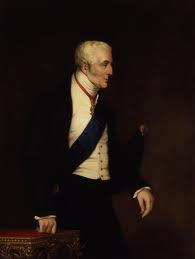
The following letters were all addressed to Lady Salisbury -
Walmer, October 11, 1850
"I sent my instruction to my Deputy Ranger yesterday of which I will send you a copy as soon as I can get one! You will see that they settle the affair. I have another likewise at the Office of Woods about the Squatter in Hyde Park, and I hope to shake that Lady off without very much difficulty. But we must proceed with caution and Regularity. . . . . ."
Walmer, October 13, 1850
"I have had nothing very interesting to tell you in the last two days! My time has been principally occupied by the Mad Men and Mad Women by whom I am pestered constantly! It is quite curious with what a number of Insane persons I am in relation. Mad retired Officers, Mad Women, etc.! I found last session that there is a Society established for the protection of those who are insane, or charged with insanity, and the Head of which is a Madman; one of the Percevals.
"I have heard no more of the Squatter! If you remember there is on the right hand side of what is called the Rotten Row, that is the Riding Road up the Park to Kensington Gardens and Kensington, a Mound or Bank which retains the water in what is called the Serpentine River! This house is placed on this mound, or rather in a Space scooped out of its thickness! for I have never seen the house!
"I rather suspect that the Woman had been allowed to establish a sort of stall on this Spot for selling oranges, cakes, etc. It is situated near a fountain, and that she has contrived to build Houses on the spot on which she had been permitted to have a stall for the sale of her oranges and Cakes. However she became established, I entertain no doubt that it will be a troublesome job to remove her! and I have determined that I will go to work regularly."
Walmer, October 15, 1850
"You will be surprised to learn that I am going to London. I am going there on the principle that the only animal who is never allowed to have any rest is the Duke of Wellington . . . I propose to avail myself of the opportunity of getting upon my horse and taking a look at the position of the Squatter in Hyde Park.
"When Sir Harry Smith was in England a year or two ago, he reminded me of my old Practice with the Army.
"When there was any difficulty and they came to me to report it, and to ask what they should do, my answer was, `I will get upon my Horse and take a look; and then tell you!' Accordingly, as soon as I shall reach my own House to-morrow, I will get upon my horse and take a look at the position of this Squatter! and I think that I shall have no difficulty in pointing out the mode as settling that one! . . . . "

London, October 17, 1850
". . . . I arrived in town prosperously yesterday afternoon; and in conformity with my intention mounted my horse and went to take a look at the position of the Squatter! She is not exactly at the Fountain, very little further on; and higher up the Bank! I entertain no doubt that it will not be difficult to remove her if necessary! But I hope that we shall prevail upon her to move off without the necessity of compulsion . . . . As long as the Duke of Cambridge was Ranger, and since his Death, nobody ever thought of wanting Police in the Parks; but now that I am Ranger, everybody has discovered that they cannot walk or take the air in security. . . . "
Walmer, October 18, 1850
" . . . . . I went to take a look at the Squatter's Premises in Hyde Park! They are quite distinct from the Fountain with which you are acquainted in which there is a spring of pure water! This last is lower down the Bank and nearer Rotten Row . . . . . "
London, November 15, 1850
". . . . Before I went to Bed at night, I received the usual summonses to attend Christenings, Dinners, Concerts, etc., this day and to-morrow. In short, there is no end of the demands upon my time . . . I have the pleasure of informing you we have got rid of the Squatter in the Park. She has quitted her Residence, which has been pulled down and the ground on which it stood or rather fell has been levelled."
This was not the end of the matter. The Squatter, namely a Mrs. Ann Hicks, was subsequently arrested in August of 1851 for selling refreshments outside the Crystal Palace. She claimed that her grandfather had rescued King George II from drowning in the Serpentine and that her family had subsequently been granted life tenancy in the Park. Her case was heard and dismissed by the House of Commons and a public appeal raised enough finds to purchase Mrs. Hicks passage to join her family in Australia.
Published on June 11, 2014 00:00
June 9, 2014
2014: 200 years for Jane Austen's Mansfield Park
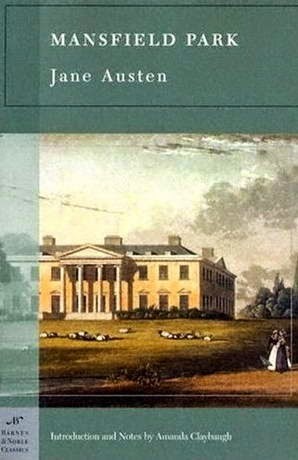
This year we are celebrating the bicentennial of Mansfield Park, Jane Austen's third published novel -- but the first she wrote completely in her maturity. Both of her previous published works, Sense and Sensibility, and Pride and Prejudice were revised versions of works she had written before she was 25.
Mansfield Park might be the least beloved of the Austen novels, primarily because the heroine Fanny Price, is difficult to adore like we adore Elizabeth Bennett or admire, as we do Elinor Dashwood. Fanny is repeatedly described as weak and meek.
Only, it seems in the presence of Edmund Bertram, her cousin, does she express her opinions. But her moral certitude is seen by many readers as over the top. She seems a prude, yet she assesses character clearly. She allows herself to be bossed around by Mrs. Norris, yet she stands up to Sir Thomas when he tries to convince her to marry Henry Crawford.
Mary Crawford is a much more attractive character, lively and independent. But perhaps too much so. Mary's views of society and morality are selfish, narrow and downright ignorant- as are many of the other leading characters: Sir Thomas, Lady Bertram, Tom, Maria, and especially Henry.
Yet Fanny is the only character who actually achieves what she wants...with the possible exception of her brother, William. I am not sure exactly where or how I got this idea, but the more I think about it, the more it seems valid. What do you think? Is Fanny the sweet child who confirms in almost all ways, and receives her greatest desire, the love of Edmund ? Or is she silently and covertly manipulating the situation until she has him hooked, a sort of passive-aggressive witch?
Mansfield Park was begun about February of 1811 and completed in summer of 1813. It was published in 1814, by Thomas Egerton, who had also put our her previous novels. After he published Emma in 1815, the more prestigious publisher, John Murray, issued a second edition of MP in 1816.

Unlike most of Austen's other novels, Mansfield Park has not enjoyed numerous significant modern adaptation for movies or television. The best of the three versions is the BBC's MP, which came out in 1983. Although the acting and script are very good, the production values are not up to HD, sad to say. I thought Sylvestra LeTouzel's Fanny was a tour de force, as was Anna Massey's Mrs. Norris. It is available on DVD and well worth watching.
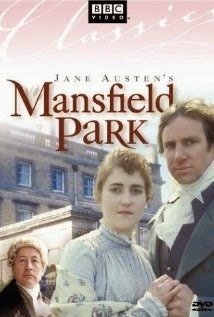
The 1999 film, the work of director Patricia Rozema, is frankly just not Mansfield Park at all. Fanny morphs into a young Jane Austen, writing some of her letters and early works. It was filmed at Kirby Hall, an interesting partial ruin of a house, which was the only good part of it, at first glance.
After my first viewing, I read more about Rozema's vision for the film and when I watched it again, I could see some of her points, including her points on the evils of slavery. But it wasn't -- and isn't Mansfield Park by Jane Austen.
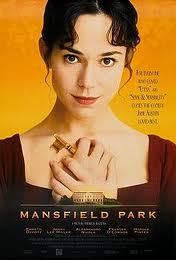
When the 2007 television version starring Billie Piper was screened, I was appalled. And I haven't given it a second try. Piper may be popular and an excellent actress -- but the part was not Fanny Price at all. If some of you loved it, please tell me why -- I might even give it another try! or not.
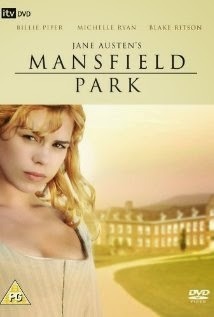
While I was playing around with my unhappy ideas about these adaptations, I came across a blog from Barnes and Noble that ranks the leading men in Austen's novels. To inject a note of fun in this post, take a look and click here.
Do you agree??? Wentworth over Darcy? Bingley over Tilney? What are they thinking?
Anyway, the best thing to do is READ the novel. Enjoy it on several levels: the beauty of the prose, the excellent delineation of character, the subtlety of the references to current events in that moment of history, and much much more
.
A very worthy blog can be found here. Sarah Emsley teaches at Harvard and concentrates her activities on Jane Austen and Edith Wharton. She and her many guest bloggers will discuss many fascinating aspects of this 200-year-old novel that still excites readers and scholars today. Sarah Emsley has a slew of cover pictures on her Pinterest page as well.Finally, I hope you can join us when the Jane Austen Society of North America holds the Annual General Meeting (AGM) in Montreal next October 10-12, 2014. I am looking forward very much to the events planned, among which will be my presentation along with Kim Wilson. for More Information, click here.

Later on I will tease you a bit about our upcoming talk.. But for now, enjoy all the info on Mansfield Park, which can be found all over the blogosphere.
Published on June 09, 2014 00:30
June 6, 2014
THE DUKE OF WELLINGTON TOUR - VIDEO HIGHLIGHTS - WINDSOR
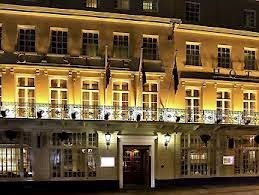
Upon arrival in Windsor, our tour group will be checking in to the Mercure Windsor Castle Hotel, where Hubby and I stayed two years ago. The hotel looks out upon Windsor Castle, the rooms are gorgeous, the bar is lined with windows and is supremely atmospheric and there's a portrait of the Duke of Wellington just off the lobby. What could be more perfect? As regular readers of this blog will know, Windsor will always mean our dear friend Hester Davenport for myself and Victoria. Windsor is a wonderful town - just the right size, full of history - even Hubby loved it during our tour to England two Decembers ago. Here is a lovely, four minute video featuring highlights in Windsor.
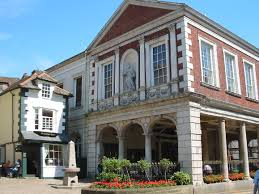
Windsor is filled with great sights, including the Guildhall and Crooked House above, Peascod Street, the playing fields of Eton and the River Thames, upon which we'll be ending our tour of Windsor with a boat cruise on the River.
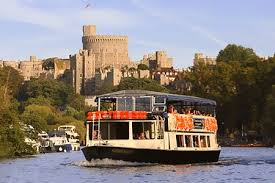
Watch scenes from a river cruise here.
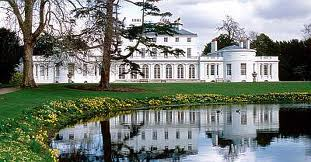
We shall also be touring Frogmore House, above, which has been used a royal retreat for three hundred years. You can watch a short video of the Prince of Wales and the royal librarian discussing artistic contributions to Frogmore House made by the daughters of King George III here. You can visit the official website for Frogmore House here and read about it's history and collections.

And finally, you can watch a short video of the sort of pomp and circumstance Windsor does so well. This is the procession for the Irish State Visit, but there's a regular changing of the guard that we may be fortunate enough to see whilst we're there.
Find Complete Details for the Duke of Wellington Tour here.
Published on June 06, 2014 00:00
June 4, 2014
VIDEO WEDNESDAY - DOWNSTAIRS AT DOWNTON ABBEY
 Mrs. Patmore and her staff in the kitchen at Downton Abbey
Mrs. Patmore and her staff in the kitchen at Downton AbbeyBy now, everyone knows that most of the "upstairs" family life depicted on Downton Abbey is shot on location at Highclere Castle. Today we take a tour with Alastair Bruce of the set at the Ealing Studios used for filming the "downstairs" scenes. (4 mins.)
In this video, the cast discusses dining downstairs at Downton (2 mins,)
An American news crew goes behind the scenes at Downton Abbey (3:51 mins.)
The "servants" explain their daily duties below stairs at Downton Abbey (3:52 mins.)
Downton's dress secrets are revealed in this video featuring the costume department (3:35 mins.)
Visit Highclere Castle with us in September as part of the Duke of Wellington Tour - Details Here
Published on June 04, 2014 00:00
June 2, 2014
A PINTEREST POST
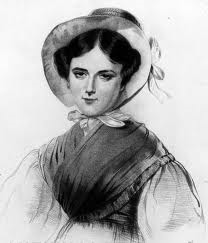
Time for another fascinating pin I found on Pinterest -
Grace Darling (24 November 1815 – 20 October 1842) was an English lighthouse keeper's daughter, famed for participating in the rescue of survivors from the shipwrecked Forfarshire in 1838. Grace's father, William was the keeper of the Longstone Lighthouse at Farne Islands.

Gazing out of her bedroom window, Grace sighted the wreck, alerted her father and the two dashed into a rowboat and out to sea, rescuing eight people, nine others were later found in a lifeboat, but dozens more lost their lives.
You can read the full story of the rescue and Grace's legacy here.
Published on June 02, 2014 00:00
THE QUEEN'S CORONATION - JUNE 2 1953
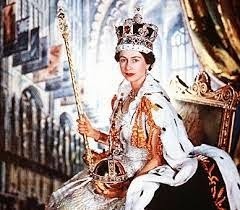
While this is not a Jubilee year, we at Number One London would still like to acknowledge the anniversary of the Queen's coronation in Westminster Abbey on 2 June, 1953, by providing the links to videos of the entire ceremony below.
Special thanks to Marsha Huff for providing the idea and the links!
https://www.youtube.com/watch?v=E8liiQb6vnM
Part 1Part 2Part 3Part 4 (with cameo appearance of Prince Charles at beginning)Part 5Part 6Part 7
Published on June 02, 2014 00:00
May 30, 2014
THE DUKE OF WELLINGTON TOUR -- VIDEO HIGHLIGHTS - WINDSOR CASTLE
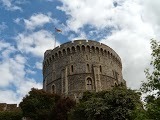
The Duke of Wellington Tour will visit Windsor Castle on Friday, September 12, 2014. It is a place of superlatives! In the words of the website, "Windsor Castle is the oldest and largest inhabited castle in the world. It has been the family home of British kings and queens for almost 1,000 years. It is an official residence of Her Majesty The Queen, whose standard flies from the Round Tower when she is in residence."
Here is a 3.5 minute official video introduction.
For a quick visit to the Royal Kitchen, click here.
For a 6.5 minute musical visit to Queen Mary's Dollhouse, click here.
This is a 9-minute recap of the April 1991 visit of Polish President Lech Walesa, with good views of the informal and formal parts of the dinner, from the 1992 BBC documentary "Elizabeth R".
We hope to get a glimpse of the latest display at Windsor Castle, an exhibit of private documents from the Royal Archives. Here is a newspaper story about it . (Non-Video, sorry)
\

Here is a 55-minute video excerpt from Windsor Castle: A Royal Year. Well worth the time!
Join us for this visit to Windsor Castle as part of The Wellington Tour
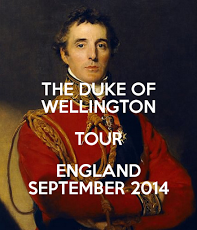
Details of The Wellington Tour are HERE
JOIN US AND HAVE THE TIME OF YOUR LIFE!
Published on May 30, 2014 00:30
May 28, 2014
VICTORIA VISITS HAMPTON, IN MARYLAND
Hampton is a mansion built in 1794, at the time the largest private home in the young United States. It is now operated by the National Park Service and you can read about the property on their website here.
 The land in the colony of Maryland was granted to a cousin of Lord Baltimore, from whose family it was purchased in 1745 by Colonel Charles Ridgely. He eventually owned more than 11,000 acres of land, on which an ironworks was established in 1760 by his son Charles Jr. During the American Revolutionary War, Captain Charles Ridgely Jr. (1733-1790) supported the patriots, supplying a variety of arms, ammunition, guns, and more to the troops. The agricultural land was worked by tenant farmers, indentured servants and slaves.
The land in the colony of Maryland was granted to a cousin of Lord Baltimore, from whose family it was purchased in 1745 by Colonel Charles Ridgely. He eventually owned more than 11,000 acres of land, on which an ironworks was established in 1760 by his son Charles Jr. During the American Revolutionary War, Captain Charles Ridgely Jr. (1733-1790) supported the patriots, supplying a variety of arms, ammunition, guns, and more to the troops. The agricultural land was worked by tenant farmers, indentured servants and slaves.
 Still a little snow in February when I visitedFarm buildings and quarters for slaves and indentured servants
Still a little snow in February when I visitedFarm buildings and quarters for slaves and indentured servants
 Octagonal Slave Quarters Source: Hampton National Historic Sitedemolished Captain Ridgely also owned a merchant fleet and he developed grand plans to build a mansion, sometimes said to have been modeled after Castle Howard in Yorkshire. Captain Ridgely died before the house was finished; most of the land, business interests and the mansion went to his nephew Charles Ridgely Carnan Ridgely (1760-1829), who finished the house and made it into the largest and most magnificent residence in the USA. He presided over a property that included ironworks, extensive grain fields, cattle, racehorses, marble quarries, millworks, and mercantile interests. He became Governor of the State of Maryland in 1815.
Octagonal Slave Quarters Source: Hampton National Historic Sitedemolished Captain Ridgely also owned a merchant fleet and he developed grand plans to build a mansion, sometimes said to have been modeled after Castle Howard in Yorkshire. Captain Ridgely died before the house was finished; most of the land, business interests and the mansion went to his nephew Charles Ridgely Carnan Ridgely (1760-1829), who finished the house and made it into the largest and most magnificent residence in the USA. He presided over a property that included ironworks, extensive grain fields, cattle, racehorses, marble quarries, millworks, and mercantile interests. He became Governor of the State of Maryland in 1815.
 Over the drawing room fireplace is a portrait of Charles Ridgely Carnan Much of the magnificence of the interior is also attributed to Eliza Ridgely (1803-67), third mistress of Hampton. She was the daughter of wealthy Baltimore wine merchant Nicolas Ridgely, said to be no relation of the various Charleses of Hampton. Eliza married Charles Carnan Ridgely II (1790-1867); she was a heiress herself and traveled extensively, collecting wherever she went. She was the mother of five children.
Over the drawing room fireplace is a portrait of Charles Ridgely Carnan Much of the magnificence of the interior is also attributed to Eliza Ridgely (1803-67), third mistress of Hampton. She was the daughter of wealthy Baltimore wine merchant Nicolas Ridgely, said to be no relation of the various Charleses of Hampton. Eliza married Charles Carnan Ridgely II (1790-1867); she was a heiress herself and traveled extensively, collecting wherever she went. She was the mother of five children.
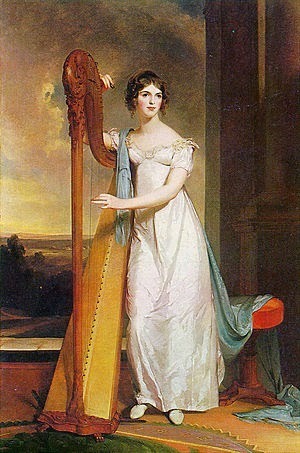 Thomas Sully, Lady With a Harp (Eliza Ridgely), 1818National Gallery of Art, Washington, D. C.
Thomas Sully, Lady With a Harp (Eliza Ridgely), 1818National Gallery of Art, Washington, D. C.
Sully (1783-1872) painted Eliza at age fifteen. She was an accomplished harpist. The painting hung at Hampton until 1945. After it came to the National Gallery, donors and officials became more interested in the fate of Hampton, which was sold to philanthropist Ailsa Mellon Bruce. She gave the property to the National Park Service in 1948. A copy of the painting hangs at Hampton.
 The Hall of Hampton mansion
The Hall of Hampton mansion
 Another view of the Hall The ground floor reception rooms and dining rooms are decorated in styles popular when the house was in its heyday from the early 1800's well into the Victorian period.
Another view of the Hall The ground floor reception rooms and dining rooms are decorated in styles popular when the house was in its heyday from the early 1800's well into the Victorian period.
 Victorian Parlor
Victorian Parlor
 Tea Table
Tea Table
 Dining Room
Dining Room
 Ready for bedtime
Ready for bedtime
 Child's bedchamber
Child's bedchamber
 Bedchamber
Bedchamber
Eliza, as well as many other owners, spent a great deal of time developing the pleasure grounds, a bowling green, the park and gardens. orchards, and kitchen gardens.
 Orangerie, replacing one destroyed by fire
Orangerie, replacing one destroyed by fire
 Hampton Mansion
Hampton Mansion
 This panel explains the original layout of the estate, now much reduced in size. The Park Service presents many educational programs throughout the year focusing on the mansion's history, the lives of the servants and slaves, the food and cooking demonstrations, and gardening.
This panel explains the original layout of the estate, now much reduced in size. The Park Service presents many educational programs throughout the year focusing on the mansion's history, the lives of the servants and slaves, the food and cooking demonstrations, and gardening.
 The land in the colony of Maryland was granted to a cousin of Lord Baltimore, from whose family it was purchased in 1745 by Colonel Charles Ridgely. He eventually owned more than 11,000 acres of land, on which an ironworks was established in 1760 by his son Charles Jr. During the American Revolutionary War, Captain Charles Ridgely Jr. (1733-1790) supported the patriots, supplying a variety of arms, ammunition, guns, and more to the troops. The agricultural land was worked by tenant farmers, indentured servants and slaves.
The land in the colony of Maryland was granted to a cousin of Lord Baltimore, from whose family it was purchased in 1745 by Colonel Charles Ridgely. He eventually owned more than 11,000 acres of land, on which an ironworks was established in 1760 by his son Charles Jr. During the American Revolutionary War, Captain Charles Ridgely Jr. (1733-1790) supported the patriots, supplying a variety of arms, ammunition, guns, and more to the troops. The agricultural land was worked by tenant farmers, indentured servants and slaves.
 Still a little snow in February when I visitedFarm buildings and quarters for slaves and indentured servants
Still a little snow in February when I visitedFarm buildings and quarters for slaves and indentured servants
 Octagonal Slave Quarters Source: Hampton National Historic Sitedemolished Captain Ridgely also owned a merchant fleet and he developed grand plans to build a mansion, sometimes said to have been modeled after Castle Howard in Yorkshire. Captain Ridgely died before the house was finished; most of the land, business interests and the mansion went to his nephew Charles Ridgely Carnan Ridgely (1760-1829), who finished the house and made it into the largest and most magnificent residence in the USA. He presided over a property that included ironworks, extensive grain fields, cattle, racehorses, marble quarries, millworks, and mercantile interests. He became Governor of the State of Maryland in 1815.
Octagonal Slave Quarters Source: Hampton National Historic Sitedemolished Captain Ridgely also owned a merchant fleet and he developed grand plans to build a mansion, sometimes said to have been modeled after Castle Howard in Yorkshire. Captain Ridgely died before the house was finished; most of the land, business interests and the mansion went to his nephew Charles Ridgely Carnan Ridgely (1760-1829), who finished the house and made it into the largest and most magnificent residence in the USA. He presided over a property that included ironworks, extensive grain fields, cattle, racehorses, marble quarries, millworks, and mercantile interests. He became Governor of the State of Maryland in 1815.
 Over the drawing room fireplace is a portrait of Charles Ridgely Carnan Much of the magnificence of the interior is also attributed to Eliza Ridgely (1803-67), third mistress of Hampton. She was the daughter of wealthy Baltimore wine merchant Nicolas Ridgely, said to be no relation of the various Charleses of Hampton. Eliza married Charles Carnan Ridgely II (1790-1867); she was a heiress herself and traveled extensively, collecting wherever she went. She was the mother of five children.
Over the drawing room fireplace is a portrait of Charles Ridgely Carnan Much of the magnificence of the interior is also attributed to Eliza Ridgely (1803-67), third mistress of Hampton. She was the daughter of wealthy Baltimore wine merchant Nicolas Ridgely, said to be no relation of the various Charleses of Hampton. Eliza married Charles Carnan Ridgely II (1790-1867); she was a heiress herself and traveled extensively, collecting wherever she went. She was the mother of five children.
 Thomas Sully, Lady With a Harp (Eliza Ridgely), 1818National Gallery of Art, Washington, D. C.
Thomas Sully, Lady With a Harp (Eliza Ridgely), 1818National Gallery of Art, Washington, D. C. Sully (1783-1872) painted Eliza at age fifteen. She was an accomplished harpist. The painting hung at Hampton until 1945. After it came to the National Gallery, donors and officials became more interested in the fate of Hampton, which was sold to philanthropist Ailsa Mellon Bruce. She gave the property to the National Park Service in 1948. A copy of the painting hangs at Hampton.
 The Hall of Hampton mansion
The Hall of Hampton mansion Another view of the Hall The ground floor reception rooms and dining rooms are decorated in styles popular when the house was in its heyday from the early 1800's well into the Victorian period.
Another view of the Hall The ground floor reception rooms and dining rooms are decorated in styles popular when the house was in its heyday from the early 1800's well into the Victorian period.
 Victorian Parlor
Victorian Parlor
 Tea Table
Tea Table
 Dining Room
Dining Room
 Ready for bedtime
Ready for bedtime
 Child's bedchamber
Child's bedchamber
 Bedchamber
BedchamberEliza, as well as many other owners, spent a great deal of time developing the pleasure grounds, a bowling green, the park and gardens. orchards, and kitchen gardens.
 Orangerie, replacing one destroyed by fire
Orangerie, replacing one destroyed by fire
 Hampton Mansion
Hampton Mansion
 This panel explains the original layout of the estate, now much reduced in size. The Park Service presents many educational programs throughout the year focusing on the mansion's history, the lives of the servants and slaves, the food and cooking demonstrations, and gardening.
This panel explains the original layout of the estate, now much reduced in size. The Park Service presents many educational programs throughout the year focusing on the mansion's history, the lives of the servants and slaves, the food and cooking demonstrations, and gardening.
Published on May 28, 2014 00:30
May 26, 2014
DANDIES IN THE MALL
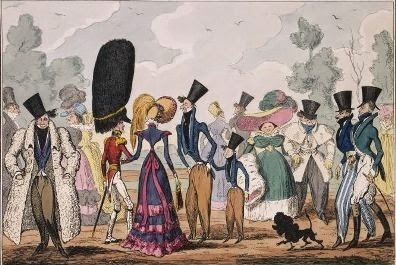
From the Journal of Mrs. Arbuthnot, May 26, 1821
I took a long ride into the country with Mr. Arbuthnot and the Duke of Wellington. The ladies and dandies have taken to ride in the Mall in St. James's Park in such numbers as to be quite a nuisance. Yesterday I am sure there must have been above 100, and in that narrow road it is really dangerous. I have therefore taken to ride into the country, and we went today over the Vauxhall Bridge, by Brixton and Tooting round to Wandsworth and home by Chelsea, a beautiful ride thro' a pretty part of Surrey, all looking right and happy, altho' we are told every day that we are ruined and starving . . . . .
Published on May 26, 2014 00:00
Kristine Hughes's Blog
- Kristine Hughes's profile
- 6 followers
Kristine Hughes isn't a Goodreads Author
(yet),
but they
do have a blog,
so here are some recent posts imported from
their feed.



